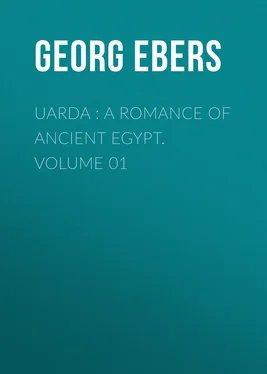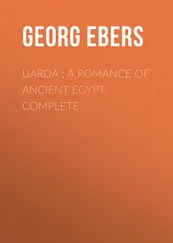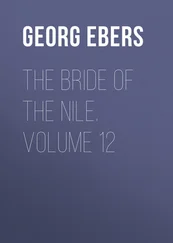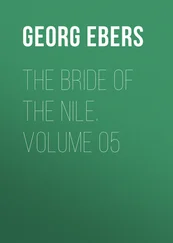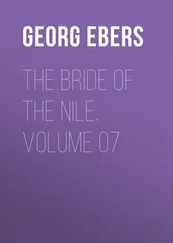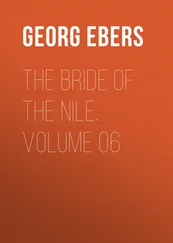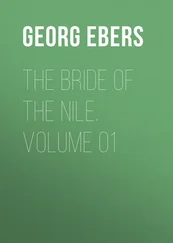Georg Ebers - Uarda - a Romance of Ancient Egypt. Volume 01
Здесь есть возможность читать онлайн «Georg Ebers - Uarda - a Romance of Ancient Egypt. Volume 01» — ознакомительный отрывок электронной книги совершенно бесплатно, а после прочтения отрывка купить полную версию. В некоторых случаях можно слушать аудио, скачать через торрент в формате fb2 и присутствует краткое содержание. Жанр: Альтернативная история, literature_19, foreign_antique, foreign_prose, Исторические приключения, на английском языке. Описание произведения, (предисловие) а так же отзывы посетителей доступны на портале библиотеки ЛибКат.
- Название:Uarda : a Romance of Ancient Egypt. Volume 01
- Автор:
- Жанр:
- Год:неизвестен
- ISBN:нет данных
- Рейтинг книги:4 / 5. Голосов: 1
-
Избранное:Добавить в избранное
- Отзывы:
-
Ваша оценка:
- 80
- 1
- 2
- 3
- 4
- 5
Uarda : a Romance of Ancient Egypt. Volume 01: краткое содержание, описание и аннотация
Предлагаем к чтению аннотацию, описание, краткое содержание или предисловие (зависит от того, что написал сам автор книги «Uarda : a Romance of Ancient Egypt. Volume 01»). Если вы не нашли необходимую информацию о книге — напишите в комментариях, мы постараемся отыскать её.
Uarda : a Romance of Ancient Egypt. Volume 01 — читать онлайн ознакомительный отрывок
Ниже представлен текст книги, разбитый по страницам. Система сохранения места последней прочитанной страницы, позволяет с удобством читать онлайн бесплатно книгу «Uarda : a Romance of Ancient Egypt. Volume 01», без необходимости каждый раз заново искать на чём Вы остановились. Поставьте закладку, и сможете в любой момент перейти на страницу, на которой закончили чтение.
Интервал:
Закладка:
Georg Ebers
Uarda : a Romance of Ancient Egypt – Volume 01
Thou knowest well from what this book arose.
When suffering seized and held me in its clasp
Thy fostering hand released me from its grasp,
And from amid the thorns there bloomed a rose.
Air, dew, and sunshine were bestowed by Thee,
And Thine it is; without these lines from me.
In the winter of 1873 I spent some weeks in one of the tombs of the Necropolis of Thebes in order to study the monuments of that solemn city of the dead; and during my long rides in the silent desert the germ was developed whence this book has since grown. The leisure of mind and body required to write it was given me through a long but not disabling illness.
In the first instance I intended to elucidate this story—like my "Egyptian Princess"—with numerous and extensive notes placed at the end; but I was led to give up this plan from finding that it would lead me to the repetition of much that I had written in the notes to that earlier work.
The numerous notes to the former novel had a threefold purpose. In the first place they served to explain the text; in the second they were a guarantee of the care with which I had striven to depict the archaeological details in all their individuality from the records of the monuments and of Classic Authors; and thirdly I hoped to supply the reader who desired further knowledge of the period with some guide to his studies.
In the present work I shall venture to content myself with the simple statement that I have introduced nothing as proper to Egypt and to the period of Rameses that cannot be proved by some authority; the numerous monuments which have descended to us from the time of the Rameses, in fact enable the enquirer to understand much of the aspect and arrangement of Egyptian life, and to follow it step try step through the details of religious, public, and private life, even of particular individuals. The same remark cannot be made in regard to their mental life, and here many an anachronism will slip in, many things will appear modern, and show the coloring of the Christian mode of thought.
Every part of this book is intelligible without the aid of notes; but, for the reader who seeks for further enlightenment, I have added some foot-notes, and have not neglected to mention such works as afford more detailed information on the subjects mentioned in the narrative.
The reader who wishes to follow the mind of the author in this work should not trouble himself with the notes as he reads, but merely at the beginning of each chapter read over the notes which belong to the foregoing one. Every glance at the foot-notes must necessarily disturb and injure the development of the tale as a work of art. The story stands here as it flowed from one fount, and was supplied with notes only after its completion.
A narrative of Herodotus combined with the Epos of Pentaur, of which so many copies have been handed down to us, forms the foundation of the story.
The treason of the Regent related by the Father of history is referable perhaps to the reign of the third and not of the second Rameses. But it is by no means certain that the Halicarnassian writer was in this case misinformed; and in this fiction no history will be inculcated, only as a background shall I offer a sketch of the time of Sesostris, from a picturesque point of view, but with the nearest possible approach to truth. It is true that to this end nothing has been neglected that could be learnt from the monuments or the papyri; still the book is only a romance, a poetic fiction, in which I wish all the facts derived from history and all the costume drawn from the monuments to be regarded as incidental, and the emotions of the actors in the story as what I attach importance to.
But I must be allowed to make one observation. From studying the conventional mode of execution of ancient Egyptian art—which was strictly subject to the hieratic laws of type and proportion—we have accustomed ourselves to imagine the inhabitants of the Nile-valley in the time of the Pharaohs as tall and haggard men with little distinction of individual physiognomy, and recently a great painter has sought to represent them under this aspect in a modern picture. This is an error; the Egyptians, in spite of their aversion to foreigners and their strong attachment to their native soil, were one of the most intellectual and active people of antiquity; and he who would represent them as they lived, and to that end copies the forms which remain painted on the walls of the temples and sepulchres, is the accomplice of those priestly corrupters of art who compelled the painters and sculptors of the Pharaonic era to abandon truth to nature in favor of their sacred laws of proportion.
He who desires to paint the ancient Egyptians with truth and fidelity, must regard it in some sort as an act of enfranchisement; that is to say, he must release the conventional forms from those fetters which were peculiar to their art and altogether foreign to their real life. Indeed, works of sculpture remain to us of the time of the first pyramid, which represent men with the truth of nature, unfettered by the sacred canon. We can recall the so-called "Village Judge" of Bulaq, the "Scribe" now in Paris, and a few figures in bronze in different museums, as well as the noble and characteristic busts of all epochs, which amply prove how great the variety of individual physiognomy, and, with that, of individual character was among the Egyptians. Alma Tadelna in London and Gustav Richter in Berlin have, as painters, treated Egyptian subjects in a manner which the poet recognizes and accepts with delight.
Many earlier witnesses than the late writer Flavius Vopiscus might be referred to who show us the Egyptians as an industrious and peaceful people, passionately devoted it is true to all that pertains to the other world, but also enjoying the gifts of life to the fullest extent, nay sometimes to excess.
Real men, such as we see around us in actual life, not silhouettes constructed to the old priestly scale such as the monuments show us—real living men dwelt by the old Nile-stream; and the poet who would represent them must courageously seize on types out of the daily life of modern men that surround him, without fear of deviating too far from reality, and, placing them in their own long past time, color them only and clothe them to correspond with it.
I have discussed the authorities for the conception of love which I have ascribed to the ancients in the preface to the second edition of "An Egyptian Princess."
With these lines I send Uarda into the world; and in them I add my thanks to those dear friends in whose beautiful home, embowered in green, bird- haunted woods, I have so often refreshed my spirit and recovered my strength, where I now write the last words of this book.
Rheinbollerhutte, September 22, 1876. GEORG EBERS.The earlier editions of "Uarda" were published in such rapid succession, that no extensive changes in the stereotyped text could be made; but from the first issue, I have not ceased to correct it, and can now present to the public this new fifth edition as a "revised" one.
Having felt a constantly increasing affection for "Uarda" during the time I was writing, the friendly and comprehensive attention bestowed upon it by our greatest critics and the favorable reception it met with in the various classes of society, afforded me the utmost pleasure.
I owe the most sincere gratitude to the honored gentlemen, who called my attention to certain errors, and among them will name particularly Professor Paul Ascherson of Berlin, and Dr. C. Rohrbach of Gotha. Both will find their remarks regarding mistakes in the geographical location of plants, heeded in this new edition.
Читать дальшеИнтервал:
Закладка:
Похожие книги на «Uarda : a Romance of Ancient Egypt. Volume 01»
Представляем Вашему вниманию похожие книги на «Uarda : a Romance of Ancient Egypt. Volume 01» списком для выбора. Мы отобрали схожую по названию и смыслу литературу в надежде предоставить читателям больше вариантов отыскать новые, интересные, ещё непрочитанные произведения.
Обсуждение, отзывы о книге «Uarda : a Romance of Ancient Egypt. Volume 01» и просто собственные мнения читателей. Оставьте ваши комментарии, напишите, что Вы думаете о произведении, его смысле или главных героях. Укажите что конкретно понравилось, а что нет, и почему Вы так считаете.
